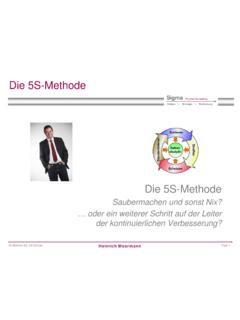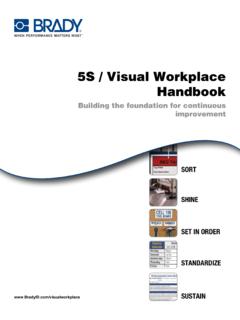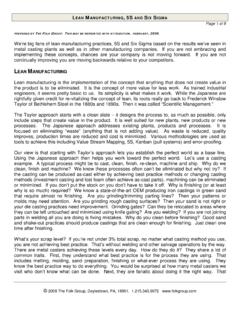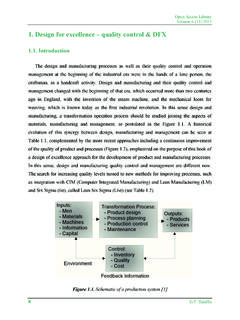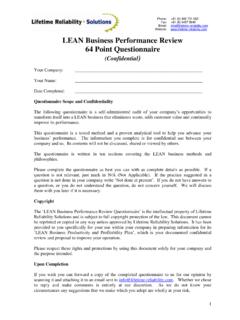Transcription of Review on Reduction of Delay in manufacturing …
1 International Journal of Scientific and Research Publications, Volume 3, Issue 2, February 2013 1. ISSN 2250-3153. Review on Reduction of Delay in manufacturing process using Lean six sigma (LSS) systems *, Dr Babu **. *Asst Professor & Research scholar, Sri Balaji Chockalingam Engineering College, Nagar Irumbedu Arni , Tamil Nadu, India **. Professor & Head, Dept of Automobile Engineering, Karpaga Vinayaga College of Engineering and Technology, GST Road, Maduranthagam Tk, Kancheepuram Dist-603 308, Tamil Nadu, India. Abstract- Lean Six Sigma is a tool that can reduce muda (waste). during the manufacturing process. Lean Six Sigma is an II. MILESTONES OF LEAN PRODUCTION SYSTEMS. integration of Six Sigma and Lean manufacturing , both quality The mass production concepts were developed in the and improvement techniques. Lean and Six Sigma are highly established by Samuel Colt and Henry Ford [7,8], and the lean complementary and Six Sigma provides an integrated production is basically emerged from the innovations in the improvement approach that increases quality by reducing Toyota production System (TPS) in Japan since the 1940s [19].
2 Variation, defects, and costs. Lean adds tools that increases especially the just-in-time (JIT) delivery of materials between process throughput by eliminating waste. There are 7 types of work stations to minimize Inventory systems. Most of the past waste that occurs during the production systems such as Delay , reviews of lean are available , Hines et Holweg, [10,9],. conveyance, over processing, correction, conveyance so on and Sugimori et al. [11] quote the first theory about the TPS, Delays occurs in the day to day process during manufacturing . emphasizing JIT production and the use of good thinking by all But in process terms, delays are one of the biggest causes of employees to continuously improve performance. Most of the ineffectiveness, inefficiencies, and poor performance. Hence, this papers on JIT and the TPS emerged in the 1980s (Ohno, 1988;. paper mainly focus on various process methodologies that are Shingo, 1989) [,21,20].According to Hopp and Spearman, Ohno used to reduce the Delay in the manufacturing process in order to [12,21].
3 Described the TPS as designed for continuous flow and improve the productivity of the manufacturing systems. based on two main principles: autonomation (best practices and standard work) and JIT (kanban and level production). Index Terms- Lean six sigma, Muda, Process Delay , Process Autonomation gives rise to practices pertaining to visual control, Improvement. mistake proofing, and housekeeping (or 5S''sort, straighten, sweep, standardize, and self-discipline), while JIT drives I. INTRODUCTION changeover Reduction .[27]. The term lean production'' was first used by Krafcik [14] and L ean six sigma is a technique and also an effort that is used to minimize the cost of the process by eliminating the waste in various service sectors. Lean philosophy identifies and removes popularized by Womack et al. [8] To some, lean is just a repackaging of JIT. For example, according to Hopp and the inefficiencies like the non value added (waste) cost or Spearman , Womack et al.
4 [12,8] freshened JIT by recasting it as unneeded wait time within the process caused by defects, excess Lean manufacturing .'''Gaither and Frazier [13] equated lean with production and other process to expand any organization. Here the philosophies and approaches embodied in JIT.'' Krafcik discussed about the various types of waste that reduces the and McLachlin [14] viewed lean and JIT as closely related. Lean efficiency of the systems such as Errors and Defects, Wasted manufacturing focuses on the elimination of wastes from an Motion/Unutilized Talent, Excess Inventory Processing and organization's operations through a set of work practices to Complexity, Transportation, Delay and Wait Time, produce products and services at the rate of demand (Womack Overproduction. Mostly 80% of process Delay are caused by 20% etal; Fullerton etal., [8,22], Lean manufacturing represents a time trap .By improving 20% of time trap, it can eliminate 80% concept that may be grouped together as distinct bundles of Delay .)
5 Here the lean is associated with speed, efficiency, and organizational practices [23].Most sources describe the essence of acceleration of process. Defining Delay as: to stop, detain, or lean production as waste Reduction '' [12] .Ohno's main focus hinder for a time; to move or act slowly; to cause to be late or was to reduce cost by eliminating waste'' [9]This emphasis on behind in movement or progress. Synonyms include: retard, waste Reduction drove practices such as inventory Reduction ( , slow, slacken, detain, put off, and postpone. As we can see, none Hall, 1983a,b), process simplification ( , Hall, 1983a) and the of these are particularly flattering terms for the process. Process identification and elimination of non-value-adding tasks[18] , for improvement is about prioritizing problems and fixing only those which Womack and Jones [8] classified tasks into three types: 1. that improve global outcomes. It is not about fixing any problem Those that add value (by directly transforming the product into that arises.)
6 In fact, you may be better off leaving some problems the form desired by its user), 2. Those that do not add value but as problems because there are more important uses of your time. are necessary with current production methods( Type 1 muda''), and 3. Those that do not add value and are unnecessary ( Type 2. muda'' or obvious waste''). Some authors have given prominence to other key practices in their definitions of lean, International Journal of Scientific and Research Publications, Volume 3, Issue 2, February 2013 2. ISSN 2250-3153. such as respect for people quality management,( , Brown and manufactured. In addition, management must provide a business Mitchell, 1991; [17] pull production ( , Brown and Mitchell, process involving planning and strategic thinking. Looking at 1991),After examining the literature on lean, Narasimhan et al. Lean and Six Sigma separately, each gives priority to different (2006) [6] noted that the essential aspect of leanness is the items of organizational performance.
7 Resulting in diminishing efficient use of resources through the minimization of waste'' returns Arnheiter, & Maleyeff, [3] However, with the (emphasis in original) and defined lean as production implementation of both Lean and Six Sigma together, the returns accomplished with minimal waste due to unneeded operations, can be on-going as shown in Figure 1 (Arnheiter, & Maleyeff, [3]. inefficient operations, or excessive buffering in operations.'' Lean approaches focus on reducing cost through process Indeed, ample scholarly sources have concluded that efficiency optimization. Six Sigma is about meeting customer requirements through waste and buffer minimization is the hallmark of lean. and stakeholder expectations, and improving quality by [27]. measuring and eliminating defects. The Lean Six Sigma Hence, Womack and Jones' later work [8] turned its focus to approach draws on the philosophies, principles and tools of both. lean implementation, moving from what'' to how'' [9] However, Lean Six Sigma's goal is growth, not just cost-cutting.)
8 Through this work, Womack and Jones (2003) [8] distilled five Its aim is effectiveness, not just efficiency. Bryne et al. [6]. principles of lean: (1) specify value in terms of the ultimate customer; (2) identify all of the tasks required to get a product or V. TYPES OF WASTE. service to that customer , map the value stream and A. Overproduction eliminate the non-value-added tasks; (3) create continuous, Parts are being produced without any new order or demand single-piece flow wherever possible; (4) only flow product when from the customer. Excess products may be sold with reduced a customer pulls it; and (5) seek perfection through an prices at the end of the industry fiscal year to match the budget or environment of continuous improvement. As it became better lower the inventory for the next year's production. [25]. understood, lean grew from a focus on JIT and other specific B. Delay and Wait Time practices performed in the TPS into an overarching philosophy or Some common wait time is caused by processing delays, paradigm of world-class operations.
9 Recent emphasis has been machine or system downtime, response time, or signature put on approaching lean using a scientific method [15] as part of a required for approval wait time. One may consider the question: dynamic learning capability . [8] .Hines et al. [10] noted that many How much time value could be added if wait time was criticisms of lean fail to acknowledge its continuing maturation. transformed into beneficial or work time? The answer is: A huge [27] amount! Likewise, here are some wait time value-added is the Delay happening.,Are you waiting for III. MILESTONES OF SIX SIGMA materials, the next machine to be ready, or extra help to complete Six Sigma programme was first launched at Motorola in the needs to change to make the flow smooth and even. 1986,by the joint efforts of some key persons among which Wait time = f (machine downtime, response time, signature Mikel Harry (Senior Engineer of the Government Electronics approval, etc.) [25]. Group), BillSmith (VP and Senior Quality Assurance manager) C.
10 Transportation and Bob Galvin (CEO). Motorola invented The Six Sigma Transportation is defined as delivered to and from outside the quality improvement process in 1986. Sixsigma provided a factory warehouse facility. The transportation of finished goods common worldwide language for measuring quality and became normally is generated by poor plant process or necessary plant a global standard.(Source: ;other sources process layouts. Transportation = f (plant process layout, travel frequently report that the official launch of Six Sigma took place distance, etc.). in 1987).This leads to the Motorola to become the First D. Processing and Complexity American company to win the Malcolm Baldrige Quality Award, Storing work-in-process (WIP) products in further locations adds in 1988.[26] The Six Sigma methodology, mainly to improve unneeded processing steps to complete the project and more. manufacturing processes,has been then be revised by General Processing =f (WIP, old machine malfunction, needed process Electric, in the mid-90s, first in the form of a Total Quality steps, WIP location, and so on)) [25].










